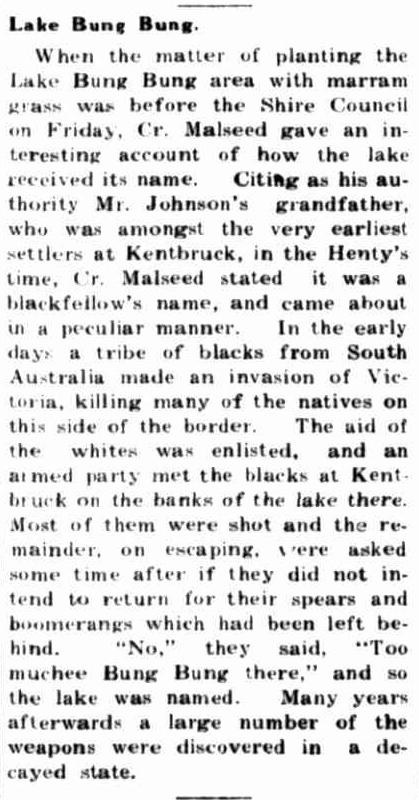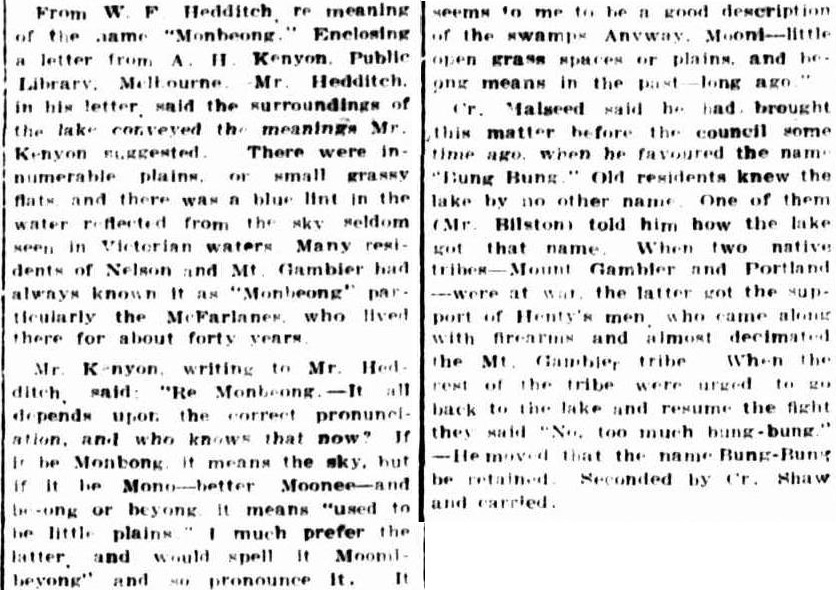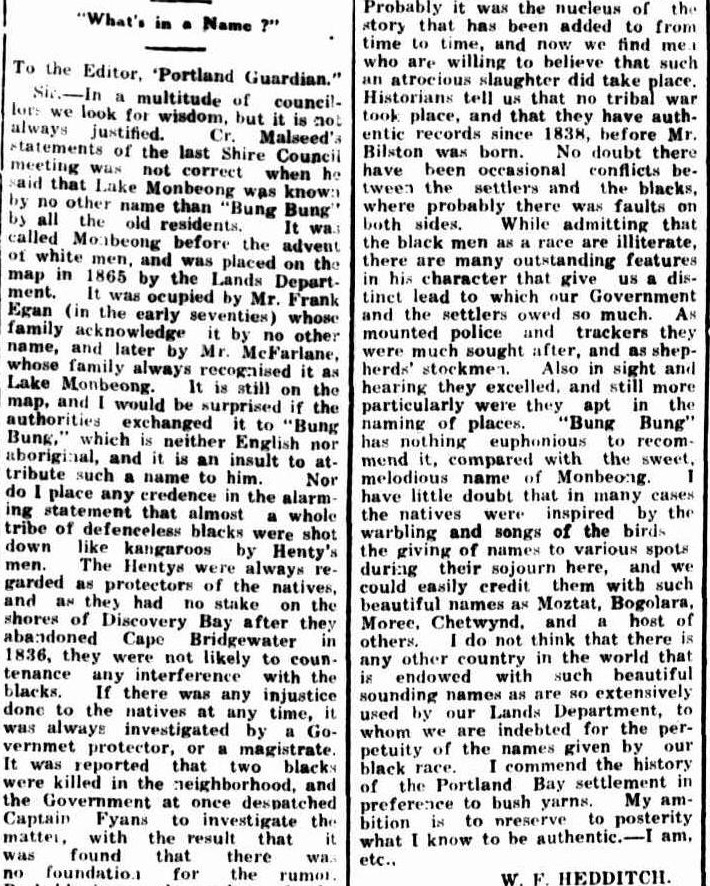Part 2: The Lake Moniboeng Naming Story – The debate between Hedditch and Malseed in the 1930s
We pick up this story again by revisiting a series of newspaper articles that appeared in the Portland Guardian in the 1930s…
As we discovered in Part 1 of this story, by the 1930s the earliest recorded name of Lake Moniboeng has morphed into (or been replaced by) several other names.
We kick things off with a contribution in 1934 from Sam H Malseed, who was a Councillor in Portland for 37 years (retiring from Council in 1949, he later died in 1951).

The first local opinion on the name of Lake Moniboeng, shared in the Portland Guardian (13th August 1934) from Councillor Sam Malseed. Note that in another probable spelling error (you will notice there are many in the articles from this era!), the Mr Johnson reported here is likely the grandson of Mr Johnstone of Swan Lake / Kentbruck, who Johnstone Creek is now named after.
This initial opinion piece eventually generated a series of responses from William F Hedditch, also a long-time local resident (who was born at Cape Bridgewater in 1957). Increasing discussion about the name around this time appears to be linked to the fact that Lake Moniboeng was of growing interest as a recreational fishing lake, with local hopes of it becoming more widely known. Initially Mr Hedditch suggests the name “Naemb Beong”, before settling on “Mombeong” a couple of years later.

Response from William Forward Hedditch, which appeared in the Portland Guardian on the 17th June 1935.

Excerpt from an opinion piece written by William Hedditch, published on the 3rd June 1937 in the Portland Guardian
The ingredients for a debate were brewing: given the involvement of two respected, long-term residents and two different, strongly held opinions. So it is no surprise that a year later, in 1938, that the debate heated up with formal submissions from William Hedditch coming before the Portland Shire Council. The first of these results in a rather jovial exchange between the Councillors present – noting that Sam Malseed was not in attendance at this meeting (his apology is noted). Interestingly on this occasion, Mr Hedditch refers to the lake as “Monbeong” – the third spelling variation in his correspondence over a 4 year period – after presumably coming across this spelling himself on an earlier dated map or document.
The second submission, in response to the March meeting request from Council seeking more information, came before the next meeting on Friday the 8th April 1938. William Hedditch had certainly done his homework, and included correspondence from A. H. Kenyon of the Public Library in Melbourne to support his case for the name “Monbeong”. This time however, with Councillor Malseed in attendance, the issue was laid to rest. Sam Malseed repeated his assertion that “Bung Bung” was the correct name, recounting his story for its origin (although this time referencing a different local elder – Mr Bilston rather than Mr. Johnstone) and even had a motion carried to support this name being retained.

The naming issue came before Council as an item of discussion at their meeting on the 8th April 1938, as reported here in the Portland Guardian on the 11th.
Although outmaneuvered at the local political level, William Hedditch was keen to ensure that the wider public knew of his discontent with how this chapter had ended. In one of his last written submissions to appear in the local paper before his death in 1939 (at 82 years of age), he responded at length to the assertons made by Councillor Malseed at the meeting in April 1938.

The final submission by William Hedditch, in support of the name Lake Monbeong, which appeared in the Portland Guardian on the 9th of May 1938.
So what should we make of this 1930s debate today?
It appears that neither of these gentlemen were able to locate the oldest written records – instead relying largely on local verbal accounts and their own strongly held opinions.
For instance, we do know that William Hedditch is partly correct in his assertions, in as much as the name Monbeong can be traced back to a map of runs from 1867 – but he doesn’t seem to have been able to locate the earliest published records of the Lang Brothers run which refer to name Lake Moniboeng. On the other hand when considering Sam Malseed’s position, the only other earlier published account in support of the name “Bung Bung” that I have come across is from the reproduced report of government officer H. Mackay, who visited the Malseed’s property in 1905. I think it is fair to assume that Mackay probably picked up the name in conversation with the Malseed’s at that time. So it is also likely that Sam Malseed learned of this name, as he states, from other residents and his own family (who were also early settlers).
But I wonder, did these gentlemen stop to consider that they might both be correct?
What if Bung Bung is not a phonetic mis-interpretation of Moniboeng or its other derivations (as is certainly possible and has been suggested) – but a completely different and newer name?
It is fascinating, and potentially disturbing, to consider this question in the context of the verbal account of a massacre at Lake Moniboeng. There are no other published references that I am aware of, of a conflict of this nature taking place at Lake Moniboeng, but does this mean that this event definitely didn’t happen? I’m not as sure as William Hedditch was in his final piece about this being so outside the realms of possibility.
For anyone who has read about early European accounts of contact with Aboriginal people in this general part of Australia (e.g.William Buckley), you may have been struck by just how frequent and violent inter-tribal conflict was between neighbouring indigenous groups. Buckley repeatedly spoke of his distress about this in his account of the decades he spent with the tribes around the area that later became Melbourne. We also know that much frontier violence of early European settlers towards indigenous people went unreported, deliberately concealed by the perpetrators and/or sometimes overlooked by the authorities (if they were even present).
With this in mind, it is not outside the realms of possibility to imagine a situation like the account reported by Sam Malseed from Mr Johnstone and Mr Bilston. After all, why would they make such an account up – unless, as William Hedditch claims, this story grew from another incident and took on a life its own? However, I tend to think that most local people would not be eager to invent stories that tarnish the reputations of the district’s earliest settlers simply to justify an “invented” place name – or did the fact that the shooting involved breaking up a conflict between two tribes somehow make it seem more acceptable to these later residents when repeating the story? What can’t be denied is that stories of a massacre – no matter how well concealed initially – are hard to prevent from at least being verbally passed down over generations (for an example of this, you might want to track down a library copy of a very good (but now out of print) book called “Fatal Collisions” which explores this complex aspect of our history in some detail, with some excellent locally relevant examples). Does this explain why some families spoke of the account, while others in the same district (where secrecy had been maintained) didn’t?
In summary, we’ll probably never know the truth of the origins of the name Bung Bung (is it a simple phonetic error, or a clue to a hidden massacre?), but luckily the written records do enable us to go back to identify the original Aboriginal name that William Hedditch was so keen to see used. In hindsight it does seem a little ironic that he was pushing hard for recognition of a name (Monbeong) that wasn’t quite historically (or in all likelihood phonetically) accurate! – with the earliest written account of the Aboriginal word for the lake (reported in Part 1) being Moniboeng.
Still to come in Part 3, we’ll fast forward to the 1940s and 50s, to close out the retrospective look at how Lake Moniboeng, now Lake Bung Bung (in the 1930s), eventually became known as Lake Monibeong.


